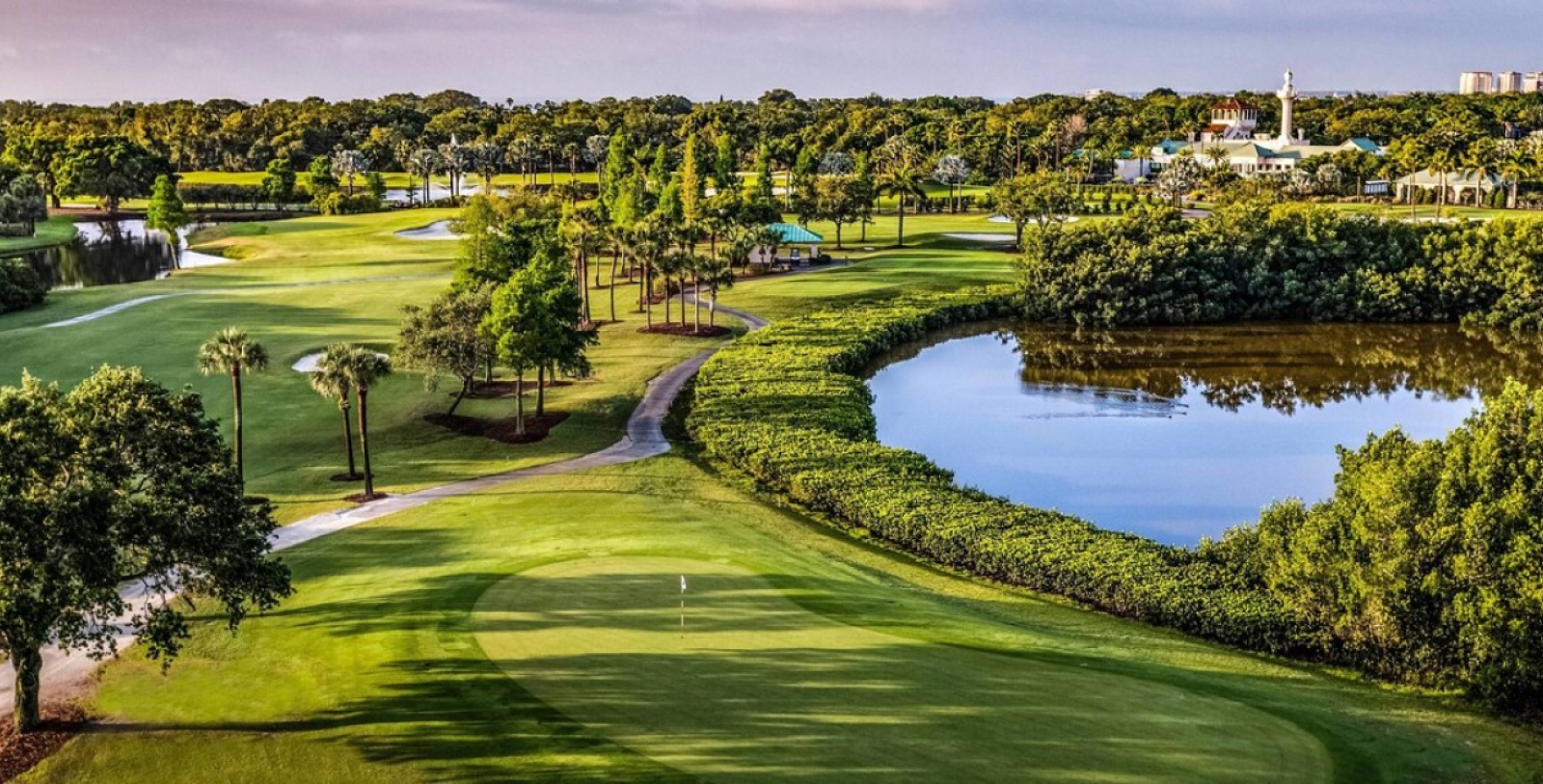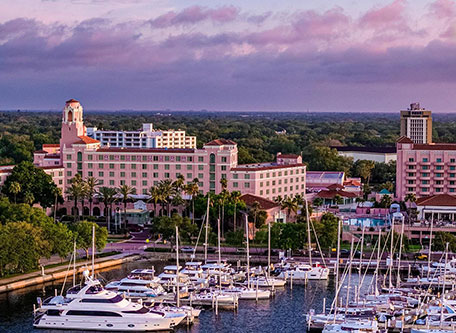Receive for Free - Discover & Explore eNewsletter monthly with advance notice of special offers, packages, and insider savings from 10% - 30% off Best Available Rates at selected hotels.
the vinoy golf course in st. petersburg
Discover the Vinoy Golf Course, which has entertained golfers of all skill levels since its debut during the Roaring Twenties.
The Vinoy Resort & Golf Club, Autograph Collection’s golf heritage dates back to the 1920s.
VIEW TIMELINEIn relation to the origins of golf at most hotels, The Vinoy Resort & Golf Club, Autograph Collection’s story is by far among the most interesting. The hotel itself first emerged due to a simple bet made during a house party at the height of the Roaring Twenties. According to the tale, a wealthy businessperson named Aymer Vinoy Laughner had specifically decided to host an exhilarating gala. One of the many guests in attendance happened to be his friend, famed professional golfer Walter Hagen. Laughner and Hagen spent much of the evening conversing before the discussion evolved into a good-natured dispute regarding the latter’s golf swing. Laughner attested that Hagen’s drive—while powerful—had no chance of damaging the crystal within his pocket watch. The conversation reached its crescendo when Hagen wagered $170,000 that he could smash its glass casing. Placing the watch firmly on the ground, Hagen proceeded to forcefully launch golf balls several dozen yards away on a distant neighbor’s lawn. But much to the golfer’s surprise, the watch had somehow survived the contest unscathed. Hagen, in turn, honorably surrendered the money to Laughner. (Hagen could afford it, though: considered one of the greatest golfers of the 20th century, he was the first player to make a million dollars while competing professionally.) Some guests mused that Laughner ought to use that money to build a spectacular holiday destination in downtown St. Petersburg. Intrigued, he opted to act on their musings and began developing the future “Vinoy Park Hotel” with help from architect Henry L. Taylor. Taking months to complete, the stunning hotel made its final debut to great acclaim on New Years’ Day, 1925.
Meanwhile, another prominent entrepreneur named C. Perry Snell debuted a fantastic nine-hole golf course a little over a mile away on what is now called “Snell Isle.” Dubbed the “Coffee Pot Golf Club,” the complex emerged as one of the top destinations to play golf in the greater St. Petersburg area. To capitalize upon its rising popularity, Snell commissioned the course’s expansion by another nine holes and added a spacious driving range for practice. Then in 1926, he hired nationally renowned architects John Van Kleek and Wayne Stiles to completely renovate the Coffee Pot Golf Club into a modern golfing facility. Together, Kleek and Stiles completely overhauled the course’s appearance to feature nine completely new holes. Those new holes were then incorporated with the nine earlier fairways to create the “Snell Island Golf Course.” The site continued to be heavily visited by countless golfers, despite the onset of the Great Depression and its impact on the local community. In fact, famed candy manufacturer D.L. Clark even made a successful bid to purchase the entire location for more than $150,000 in 1932! The golf course changed hands yet again after World War II, when it went to the owners of the Vinoy Park Hotel. Renamed as the “Vinoy Golf Course,” the destination flourished under the stewardship of the hotel. Indeed, the hotel’s management continued to preserve its historical character over the following decades, including a comprehensive revitalization that golf course architect Ron Garl oversaw in 1992. The Vinoy Golf Couse has since remained an integral part of the Vinoy Park Hotel, which operates today as The Vinoy Resort & Golf Club, Autograph Collection.
-
About the Location +
Located at the southern end of the Pinellas Peninsula along Tampa Bay, the history of St. Petersburg, Florida, is immensely interesting. The earliest people to frequent the region were Native Americans, who occupied the space for generations. But in the early 16th century, a pair of the Spanish explorers journeyed through the area in search of fame and treasure. The first of the two adventurers—Pánfilo de Narváez—arrived in 1528 with an army of some 300 men. Heading deep into the interior, his party reemerged from its trek with just four survivors! Narváez himself had died, too, as the raft he used during his return trip was swept away into the Gulf of Mexico. Undeterred, Hernando de Soto arrived with his own troop a decade later. From Tampa Bay, de Soto ventured all across what is now the Deep South, reaching as far as the banks of the Mississippi River in present-day Louisiana. Like his predecessor, Hernando de Soto had died while leading his expedition. Nevertheless, Florida became part of the Spanish Empire for the next three centuries, save for a brief period in the mid-1700s when it was a British colony. While Pinellas Peninsula remained relatively isolated, settlers stared to congregate toward the northern end of Tampa Bay shortly after the United States acquired Florida from Spain in 1821. The main force behind the development was the U.S. Army, which had dispatched four companies of soldiers to erect a fort.
Known as “Fort Brooke,” the citadel and its garrison effectively served as the only settled community in the entire region. Fort Brooke served as an important post as it defended against the attacks by the Seminoles, who, since the 1810s, had continuously challenged the settlement of the area. When the fighting ceased toward the middle of the century, other settlers started to move to Tampa Bay in large numbers. Pinellas Peninsula was an afterthought for many though, and it remained an undeveloped wetland through the American Civil War. But when Florida began its transformation into a luxurious vacation hotspot in the years after the conflict, some Americans finally recognized the commercial real estate value of the region. One such person was John C. Williams, a transplant from Detroit, Michigan, who had travelled south in search of prospective economic opportunities. In 1875, he purchased a large plot of land in the Pinellas Peninsula from Captain Peter Demens and subsequently convinced him to help found a brilliant new city. Although it grew slowly, the new City of St. Petersburg received a formal charter from the Florida state legislature in February of 1892. Local legend has it that Williams and Demens chose the name of “St. Petersburg” with a coin flip. Demens won the toss, deciding to name the new community after St. Petersburg, Russia. Both Williams and Demens quickly set about developing their new community into an exclusive resort town. The two specifically constructed a magnificent hotel in the center of St. Petersburg that Williams christened in honor of his birthplace.
The town’s population nonetheless remained fairly small, only numbering a few people at the dawn of the 20th century. At the time, the economy of St. Petersburg operated on commercial fishing and other small enterprises. Its maritime commerce improved significantly over the next several years, as city officials began dredging the local harbor into a deep-water port. However, several important developments transpired during 1910 that ultimately turned the city into a popular vacation retreat. Al Lang convinced the St. Louis Browns to relocate its spring training facilities to St. Petersburg, creating the tradition in which many professional baseball clubs held their preseason activities in the area. Furthermore, commercial airplane flights began running exclusively to St. Petersburg, beginning with Tony Jannus and his Benoist XIV flying boat. Those two developments—combined with the town’s naturally beautiful beaches—had quickly made it one of Florida’s most well-known destinations. By the 1920s, thousands of tourists from throughout the Northeast had descended upon St. Petersburg for an enjoyably relaxing holiday. As with most coastal Floridian towns, a massive land boom subsequently erupted throughout St. Petersburg. Dozens of outstanding hotels and resorts—including the Vinoy Park Hotel—debuted, as such. Today, St. Petersburg has since continued to be one of Florida’s most outstanding locations.
-
About the Architect +
John Van Kleek and Wayne Stiles: The two men who would eventually develop the Vinoy Golf Course had venerable professional histories. Kleek himself hailed from Auburn, New York, and graduated with a master's in landscape design from Cornell University on the eve of World War I. Stiles, however, was never formally trained in landscape architecture. Instead, he got his experience serving as an apprentice under the accomplished Franklin Brett during the early 20th century. Stiles worked his way up from draftsmen to be one of Brett’s junior partners in a matter of years. The pair eventually learned about one another and became impressed with the other’s skills. In 1924, Kleek and Stiles finally decided to form a landscaping firm based upon their mutual level of respect. While each man would focus on a specific area of work, the two nonetheless accepted a number of diverse jobs. In fact, their company functioned as a subcontractor to the Olmsted family, who hired them to help with several public works assignments. The exposure soon enabled Kleek and Stiles to operate on a national level, with offices open in Boston, New York City, and St. Petersburg, Florida. Some of the projects that the two began to pursue was the creation of golf courses all over the Eastern Seaboard. Even though the team coordinated closely on every course they designed, it was Stiles who took the lead. Contemporaries often recalled how invested Stiles would become on such assignments, even walking the courses in their entirety to observe the construction firsthand. When the Great Depression finally befell the nation, Kleek and Stiles dissolved their company and went their separate ways. But their team had still developed several dozen golf courses throughout the lifetime of the partnership. Among the most famous created under their watch included the Haverhill Country Club, the Brigantine Golf Links, and the future Vinoy Golf Course.
































